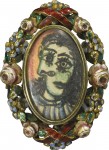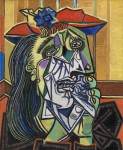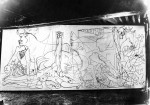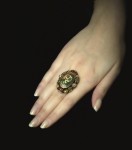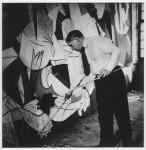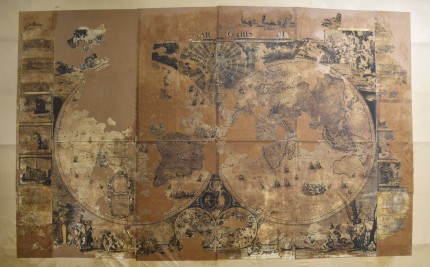 Archaeologists have unearthed the remains of a major Aztec temple and ball game court in downtown Mexico City. The remains of the massive temple dedicated to Ehecatl-Quetzalcoatl, the Aztec god of benign rain-bringing winds, were discovered just to the north of the city’s main square, the Zocalo, behind the Mexico City Metropolitan Cathedral. A hotel that collapsed during the catastrophic 1985 earthquake once stood on the site. The owners of the hotel realized there were ruins underneath the rubble and alerted Mexico’s National Institute of Anthropology and History (INAH), but the century would turn before a thorough archaeological excavation of the site could be arranged.
Archaeologists have unearthed the remains of a major Aztec temple and ball game court in downtown Mexico City. The remains of the massive temple dedicated to Ehecatl-Quetzalcoatl, the Aztec god of benign rain-bringing winds, were discovered just to the north of the city’s main square, the Zocalo, behind the Mexico City Metropolitan Cathedral. A hotel that collapsed during the catastrophic 1985 earthquake once stood on the site. The owners of the hotel realized there were ruins underneath the rubble and alerted Mexico’s National Institute of Anthropology and History (INAH), but the century would turn before a thorough archaeological excavation of the site could be arranged.
 The announcement of the discovery is the culmination of seven years of excavation work spearheaded by the Urban Archeology Program (PAU) with the collaboration of INAH. Led by archaeologist Raúl Barrera, the PAU seeks to rediscover the remains of the sacred precinct of Tenochtitlan currently buried under historic downtown Mexico City to bring to the light the Aztec history that Spanish conquistador Hernán Cortés did his best to obliterate from the landscape and memory in 1521.
The announcement of the discovery is the culmination of seven years of excavation work spearheaded by the Urban Archeology Program (PAU) with the collaboration of INAH. Led by archaeologist Raúl Barrera, the PAU seeks to rediscover the remains of the sacred precinct of Tenochtitlan currently buried under historic downtown Mexico City to bring to the light the Aztec history that Spanish conquistador Hernán Cortés did his best to obliterate from the landscape and memory in 1521.
 This temple was built 1486 and 1502, so it had only a few decades of glory before its destruction. All construction and improvements ended in 1519. Cortés and his army reached Tenochtitlan in November of 1519. Remarkably, a significant amount of the original white stucco cladding has survived. The remains of the temple attest to what a grand structure it was before it was razed by Cortés. The rectangular platform that formed its base is between 34 and 36 meters (112-118 feet) long. There are two large circular structures on top of the back part of the rectangle, the largest of which is 18 meters (59 feet) in diameter. They are separated by a walkway 1.1 meters (3.6 feet) wide.
This temple was built 1486 and 1502, so it had only a few decades of glory before its destruction. All construction and improvements ended in 1519. Cortés and his army reached Tenochtitlan in November of 1519. Remarkably, a significant amount of the original white stucco cladding has survived. The remains of the temple attest to what a grand structure it was before it was razed by Cortés. The rectangular platform that formed its base is between 34 and 36 meters (112-118 feet) long. There are two large circular structures on top of the back part of the rectangle, the largest of which is 18 meters (59 feet) in diameter. They are separated by a walkway 1.1 meters (3.6 feet) wide.
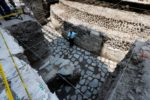 The rectangle and circular platforms together are 4 meters (13 feet) high, a fraction of the size of the temple when it was intact. As the dozens of other monumental buildings in the sacred precinct were square, the rounded design of Ehecatl’s temple would have stood out even in an area so densely packed with architectural wonders. Archaeologist and Aztec specialist Eduardo Matos believes the top of the temple would have been carved to looked like a coiled snake, its flared nostrils acting as a dramatic entryway for priests.
The rectangle and circular platforms together are 4 meters (13 feet) high, a fraction of the size of the temple when it was intact. As the dozens of other monumental buildings in the sacred precinct were square, the rounded design of Ehecatl’s temple would have stood out even in an area so densely packed with architectural wonders. Archaeologist and Aztec specialist Eduardo Matos believes the top of the temple would have been carved to looked like a coiled snake, its flared nostrils acting as a dramatic entryway for priests.
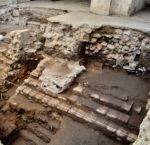 About 20 feet south of the temple is another exciting find from the late Aztec period: the remains of a court where the Mesoamerican ball game was played. Archaeologists excavated a platform nine meters (30 feet) wide. On the north side is a double staircase of four steps each that was a direct path to the Temple of Ehecatl. On the south side are three overlapping walls that slope backward. These are the remains of the stands, stadium seating Aztec style.
About 20 feet south of the temple is another exciting find from the late Aztec period: the remains of a court where the Mesoamerican ball game was played. Archaeologists excavated a platform nine meters (30 feet) wide. On the north side is a double staircase of four steps each that was a direct path to the Temple of Ehecatl. On the south side are three overlapping walls that slope backward. These are the remains of the stands, stadium seating Aztec style.
 Under the staircase, archaeologists found multiple groups of human cervical vertebrae still in their original anatomical positions. The neck bones came from 32 individuals, all of them male, all of them children ranging in age from neonates to toddlers to six-year-olds to adolescents. Cut marks on the bones indicate the children were decapitated or sacrificed as part of the ball game ritual. These are the only ritual offerings discovered in the excavation of this site, which is unique and of itself. (The Temple of Ehecatl-Quetzalcoatl unearthed in another part of Mexico City in 2014-2016 included the skeletal remains of more than a dozen individuals.)
Under the staircase, archaeologists found multiple groups of human cervical vertebrae still in their original anatomical positions. The neck bones came from 32 individuals, all of them male, all of them children ranging in age from neonates to toddlers to six-year-olds to adolescents. Cut marks on the bones indicate the children were decapitated or sacrificed as part of the ball game ritual. These are the only ritual offerings discovered in the excavation of this site, which is unique and of itself. (The Temple of Ehecatl-Quetzalcoatl unearthed in another part of Mexico City in 2014-2016 included the skeletal remains of more than a dozen individuals.)
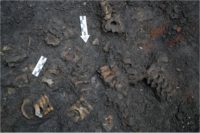
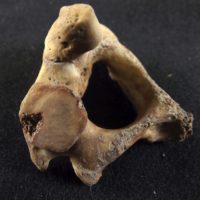
These discoveries are highly significant taken on their own, but they take on even greater significance because of what they can tell us about the geographical relationships between buildings in the sacred precinct of Tenochtitlan.
“Due to finds like these, we can show actual locations, the positioning and dimensions of each one of the structures first described in the chronicles,” said Diego Prieto, head of Mexico’s main anthropology and history institute.
The excavation isn’t completed yet, but when it’s done, the archaeological site will be converted into a museum.
